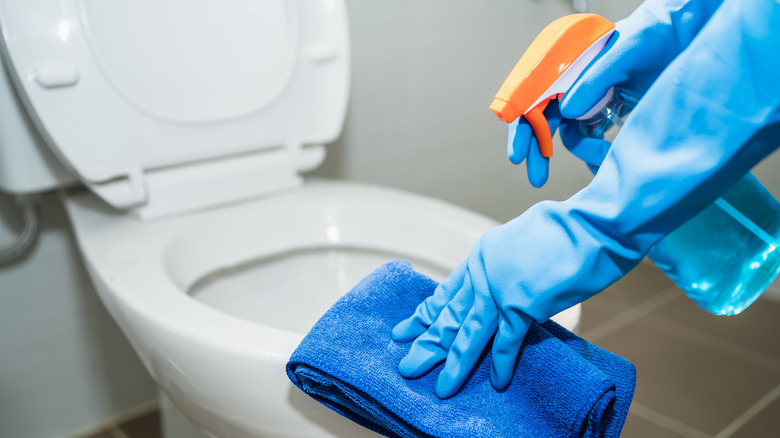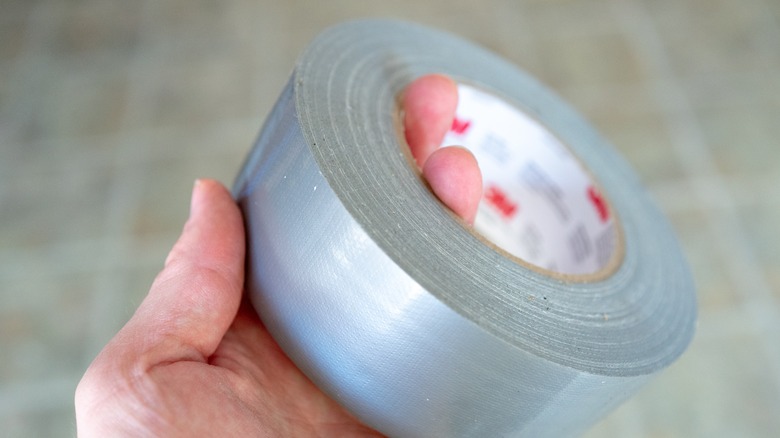TikTok's Clever Trick For Cleaning Black Mold In Your Toilet
We may receive a commission on purchases made from links.
You thought you were doing everything right. You scrub under the rim every time you clean the toilet, you use mold-banishing cleaning products, and you have even changed the way you install your toilet rim cleaner to make it more effective. But much to your dismay, that gross black mold just won't let go of its hold on your toilet. Before you rip out your failing lavatory and drive it to the dump, try this easy DIY cleaning method from TikToker @cleansnob, which uses gravity and the toilet's in-built mechanics to clean under the rim. All you need is a roll of duct tape, a gallon of white vinegar, and a toilet brush. That's it; it really couldn't be any simpler!
Black mold thrives in dark, damp places, and toilet bowl rims are both, so they're prone to harboring colonies of this nasty fungus. The color doesn't indicate how harmful it is; in fact, there's no scientific evidence proving that black mold specifically is detrimental to our health. Rather molds, generally, can trigger allergies. They're very unsightly though. Worse, a black mold-covered toilet suggests that it isn't cleaned regularly. It's difficult to see up under the rim, making it hard to check whether your scrubbing efforts have worked. Using the toilet's flush mechanism allows you to get into all the crevices even the smallest brush can't.
Gather everything you need
Duct tape is the go-to over other tapes because it's sticky enough to stay put yet easily removed once you're finished cleaning. While there's no exact size of duct tape required for this method, it's better to use tape on the thicker side. You'll be able to work faster and get a better seal. Walmart sells 25-yard rolls of 1.88-inch wide Gorilla All-Weather black tape for $12.23. Or get a 3-pack of 1.88-inch wide 3M general-purpose duct tape (105 yards long) for $12.98 from Lowe's.
Next, you'll need a big bottle of kitchen vinegar — distilled white vinegar is best. Can you really get rid of mold using vinegar, though? Absolutely. Vinegar works as a mold killer because it contains acetic acid, a compound fatal to most mold species. If you don't have some in the pantry already, get two 1-gallon bottles of Iberia natural distilled white vinegar at 5% acidity for $23.98 on Amazon.
When it comes to mold, especially potentially allergy-inducing black mold, don't compromise your safety. Grab a pair of long gloves and wear a mask if you're particularly sensitive. After all, you'll be bending over the toilet bowl for a while, getting that tape in place. You'll also need a toilet brush, which you'll use to clean the toilet both before you get to work and after you've hit the flush button for the final time. Look for one with a rim cleaner feature, ideally.
It's time to banish that mold
First, turn off the water completely. Then, flush the toilet to empty the tank. Put on your gloves and mask, and clean the bowl. Allow it to dry completely so the duct tape will stick. Tear off a long strip of tape. Note how far down the bowl the outside edge of the rim reaches, then stick the horizontal edge of the tape there. Stick the other edge to the outside rim, covering the channel the water comes from when you flush. Repeat the procedure until you've covered the entire rim, blocking the flow of water. Lift the lid on the toilet tank and pour vinegar into the tank. The flapper — that bit covering the outlet hole at the bottom of the tank — should be completely submerged.
Replace the lid and hit the flush button. The vinegar will flow from the tank and, trapped by the duct tape covering the rim, kill any hidden black mold the brush can't get at. Remove all the tape after 12 to 24 hours and flush the toilet again to dislodge the eradicated mold. Scrub the rim thoroughly with the brush to remove any remaining debris. Your toilet will be sparkling! If not, repeating the process once more should clear all the black mold out. To treat more stubborn mold, you could also seal the rim with removable caulking sealant, the type used to temporarily weather seal windows and doors, and leave the vinegar soaking longer — say, for days instead of overnight.

